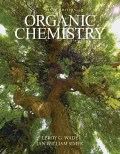
EBK ORGANIC CHEMISTRY
9th Edition
ISBN: 8220102744097
Author: SIMEK
Publisher: PEARSON
expand_more
expand_more
format_list_bulleted
Concept explainers
Question
Chapter 25.8B, Problem 25.13P
(a)
Interpretation Introduction
Interpretation:
The isoprene units in the given terpenes are to be circled.
Concept introduction:
An isoprene unit is bunched of five-carbon atoms. In terpenes, the isoprene units are connected to each other in head to tail fashion. The head part of an isoprene unit is branched, whereas the tail part of an isoprene unit is unbranched.
(b)
Interpretation Introduction
Interpretation:
The identification of the given terpenes as a monoterpene, sesquiterpene or diterpene is to be stated.
Concept introduction:
An isoprene unit is bunched of five-carbon atoms. In terpenes, the isoprene units are connected to each other in head to tail fashion. The head part of an isoprene unit is branched, whereas the tail part of an isoprene unit is unbranched.
Expert Solution & Answer
Want to see the full answer?
Check out a sample textbook solution
Students have asked these similar questions
Consider the synthesis. What is compound Y? Please explain what is happening in this question. Provide a detailed explanation and a drawing to show how the compound Y creates the product. The correct answer is D.
What would be the major product of the following reaction? Please include a detailed explanation of what is happening in this question. Include steps and a drawing to show this reaction proceeds and how the final product is formed. The correct answer is B. I put answer D and I don't really understand what is going on in the question.
What is the product of the following reaction? Please explain what is happening in this question. Provide a detailed explanation and a drawing showing how the reagent is reacting with the catalysts to product the correct product. The correct answer is B.
Chapter 25 Solutions
EBK ORGANIC CHEMISTRY
Ch. 25.3 - Prob. 25.1PCh. 25.3A - Prob. 25.2PCh. 25.3B - Give an equaton for the complete transestenfcation...Ch. 25.4 - Prob. 25.4PCh. 25.4 - Several commercial laundry soaps contain...Ch. 25.4 - Prob. 25.6PCh. 25.4 - Prob. 25.7PCh. 25.5 - Prob. 25.8PCh. 25.6 - How would you use a simple extraction to separate...Ch. 25.6 - Prob. 25.10P
Ch. 25.8A - Circle the isoprene units in geranial, menthol,...Ch. 25.8B - Prob. 25.12PCh. 25.8B - Prob. 25.13PCh. 25 - Prob. 25.14SPCh. 25 - Prob. 25.15SPCh. 25 - Show how you would convert oleic acid to the...Ch. 25 - Give the general classification of each compound....Ch. 25 - Phospholipids undergo saponification much like...Ch. 25 - Prob. 25.19SPCh. 25 - Prob. 25.20SPCh. 25 - Prob. 25.21SPCh. 25 - Prob. 25.22SPCh. 25 - Prob. 25.23SPCh. 25 - The structure of limonene appears in Problem25-13....Ch. 25 - Prob. 25.25SPCh. 25 - Prob. 25.26SPCh. 25 - Prob. 25.27SPCh. 25 - Prob. 25.28SPCh. 25 - Prob. 25.29SPCh. 25 - Prob. 25.30SPCh. 25 - Prob. 25.31SPCh. 25 - Prob. 25.32SP
Knowledge Booster
Learn more about
Need a deep-dive on the concept behind this application? Look no further. Learn more about this topic, chemistry and related others by exploring similar questions and additional content below.Similar questions
- What is the missing intermediate 1 and the final product 2. Please include a detailed explanation explaining the steps of malonic ester synthesis. Please include drawings of the intermediate and how it occurs and how the final product is former.arrow_forwardWhat would be the reagents and conditions above and below the arrow that will complete the proposed acetoacetic ester synthesis? If it cannot be done efficiently, then I will choose that answer. There could be 2 or 4 reagents involved. Please provide a detailed explanation and drawings showing how it would proceed with the correct reagents.arrow_forwardFor benzene, the ∆H° of vaporization is 30.72 kJ/mol and the ∆S° of vaporization is 86.97 J/mol・K. At 1.00 atm and 228.0 K, what is the ∆G° of vaporization for benzene, in kJ/mol?arrow_forward
- The reaction Q(g) + R(g) → Z(l) is shown to be exothermic. Which of the following is true concerning the reaction. it is spontaneous only at High T, it is spontaneous at low T it is nonspontaneous at all T it is spontanrous at all T. it is non spontaneous only at low T.arrow_forwardThe reaction Q(g) + R(g) → Z(l) is shown to be exothermic. Which of the following is true concerning the reactionarrow_forwardWhich of the following has the largest standard molar entropy, S° (298.15 K) He H2 NaCl KBr Hgarrow_forward
- Which of the following is true for a particular reaction if ∆G° is -40.0 kJ/mol at 290 K and –20.0 kJ/mol at 390 K?arrow_forwardWhat is the major product of the following reaction? O O OH OH 1. BH 2. H₂O₂, NaOH OH OHarrow_forwardDraw the products formed when each ester is hydrolyzed with water and sulfuric acid.arrow_forward
arrow_back_ios
SEE MORE QUESTIONS
arrow_forward_ios
Recommended textbooks for you
 Organic Chemistry: A Guided InquiryChemistryISBN:9780618974122Author:Andrei StraumanisPublisher:Cengage Learning
Organic Chemistry: A Guided InquiryChemistryISBN:9780618974122Author:Andrei StraumanisPublisher:Cengage Learning Chemistry for Today: General, Organic, and Bioche...ChemistryISBN:9781305960060Author:Spencer L. Seager, Michael R. Slabaugh, Maren S. HansenPublisher:Cengage Learning
Chemistry for Today: General, Organic, and Bioche...ChemistryISBN:9781305960060Author:Spencer L. Seager, Michael R. Slabaugh, Maren S. HansenPublisher:Cengage Learning

Organic Chemistry: A Guided Inquiry
Chemistry
ISBN:9780618974122
Author:Andrei Straumanis
Publisher:Cengage Learning

Chemistry for Today: General, Organic, and Bioche...
Chemistry
ISBN:9781305960060
Author:Spencer L. Seager, Michael R. Slabaugh, Maren S. Hansen
Publisher:Cengage Learning